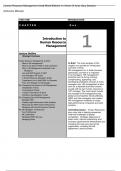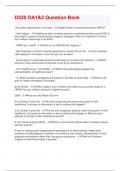(Human Resource Management (Arab World Edition) 1e Akram Al Ariss Gary Dessler)
(Insturctor Manual)
PART ONE INTRODUCTION
C H A P T E R T O n e
Lecture Outline
Introduction to
Human Resource
Management 1
Strategic Overview
Human Resource Management at Work
What is HR Management? In Brief: The main purpose of this
What is the state of HRM in Arab countries? chapter is to provide an introductory
Why is HR Management Important to all overview of what
Managers? HR management is, in Arab countries
Line and Staff Aspects of HRM specifically, and why it is important
Line Managers’ HR Duties to all managers. HR management
A Human Resource Manager’s Duties activities such as hiring, training,
Cooperative Line & Staff HRM: An Example compensating, appraising, and
From Line Manager to HR Manager
developing employees are part of every
manager’s job. HR management is also
The Changing Environment of HR Management
seen as a separate business function,
Globalization Trends
usually with its own human resource or
Technological Trends
‘HR’ manager. The main topics include
Trends in the Nature of Work
the manager’s HR management jobs,
Workforce Demographic Trends global and competitive trends affecting
The Changing Role of HR Management HRM, and how managers use modern
Strategic HRM HR management methods to create
Creating High-Performance Work Systems high-performance companies and work
Measuring the HRM Team’s Performance systems.
Managing with the HR Scorecard Process
The HR Manager’s Proficiencies Interesting Issues: Human Resources
Four Proficiencies play a key role in helping companies
HR Certification meet the challenges of global
Managing Within the Law competition. Strategic objectives to
Managing Ethics lower costs, improve productivity and
increase organizational effectiveness are
changing the way every part of the
organization, including the HR
department, does business.
,LEARNING OBJECTIVES
1. Explain what human resource management is and how it relates to the management
process.
2. Give at least eight examples of how all managers can use human resource management
concepts and techniques.
3. Illustrate the human resource responsibilities of line and staff (HR) managers.
4. Provide a good example that illustrates HR’s role in formulating and executing company
strategy.
5. Write a short essay that addresses the topic: Why metrics and measurement are crucial
to today’s HR managers.
ANNOTATED OUTLINE
I. Human Resource Management at Work – The Management process
involves the following functions: planning, organizing, staffing, leading, and
controlling. The “people” or personnel aspects of management jobs involve
conducting job analyses; planning labor needs and recruiting job candidates;
selecting job candidates; orienting and training new employees; managing
wages and salaries; providing incentives and benefits; appraising
performance; communicating; training and developing managers; and,
building employee commitment;
A. What is the State of HR Management in Arab Countries? In Arab
countries, macro-contextual elements such as culture, history, economy,
political issues, local policies such as nationalization, as well as religion,
all influence the management of people. Therefore, most companies are
now required to understand how to manage their people according
to local and global understandings.
B. Why Is HR Management Important to All Managers? Managers don’t
want to make mistakes while managing, such as hiring the wrong
person, having their company taken to court because of discriminatory
actions, or committing unfair labor practices.
C. Line and Staff Aspects of HRM – Although most firms have a human
resource department with its own manager, all managers tend to get
involved in activities like recruiting, interviewing, selecting, and training.
1. Line Versus Staff Authority – Authority is the right to make decisions,
to direct the work of others, and to give orders. Line managers are
authorized to direct the work of subordinates. Their subordinates are
generally involved in work that directly produces or sells the
company’s product or service, like Sales or Manufacturing. Staff
managers are authorized to assist and advise line managers in
accomplishing their basic goals. The subordinates of staff managers
are generally involved in work that supports the products or services,
in departments like Purchasing, or Quality Control. HR managers are
generally staff managers.
D. Line Managers’ HR Duties – Most line managers are responsible for line
functions, coordinative functions, and some staff functions.
, E. A Human Resource Manager’s Duties – Human Resource Managers also
have line, coordinative and staff functions. However, they exert line
authority only within the HR department. They have implied authority with
line managers due to the fact that they have the ear of top management
on many important issues contributing to organizational health.
F. Cooperative Line and Staff HR Management: An Example – In recruiting
and hiring, it is generally the line manager’s responsibility to specify the
qualifications employees need to fill specific positions. Then the HR staff
takes over. They develop sources of qualified applicants and conduct
initial screening interviews. They administer appropriate tests, then refer
the best applicants to the supervisor (line manager), who interviews and
selects the ones he/she wants. In Arab countries, employers split most
HR duties between HR and line managers. HR managers in Bahrain,
Oman, and Saudi Arabia play a key role in applying labor nationalization
policies.
G. From Line Manager to HR Manager – Line managers may make career
stopovers in staff HR manager positions.
➢ NOTES Educational Materials to Use
II. The Changing Environment of HR Management - Human Resource
responsibilities have become broader and more strategic over time in
response to a number of trends. Changes are occurring today that are
requiring HR managers to play an increasing central role in managing
companies. These changes or trends include globalization, changes in the
nature of work, and technology.
A. Globalization Trends – Globalization refers to the tendency of firms to
extend their sales, ownership, and/or manufacturing to new markets
abroad. Globalization of the world economy and other trends has
triggered changes in how companies organize, manage and use their HR
departments. The rate of globalization continues to be high, and has
several strategic implications for firms.
1. Globalization’s Implications – More globalization means more
competition, and more competition means more pressure to lower
costs, make employees more productive, and do things better and
less expensively. This trend is increasingly evident in the Arab world.
B. Technological Trends – Virtual online communities, virtual design
environments and Internet-based distribution systems have enabled
firms to become more competitive. HR faces the challenge of quickly
applying technology to the task of improving its own operations. Thus,
countries like Saudi Arabia have set regulations on e-transactions in
order to enhance the use of technology in businesses.
C. Trends in the Nature of Work – Jobs are changing due to new
technological demands. Dramatic increases in productivity have allowed
manufacturers to produce more with fewer employees.
, 1. Service Jobs – Most newly created jobs are and will continue to be
in the service sector. Today, a large number of people in the Arab
countries are employed in producing and delivering services rather
than products—the result has been an increase in both service and
manufacturing businesses in the Arab world.
2. Knowledge Work and Human Capital – refers to the knowledge,
education, training, skills, and expertise of a firm’s workers. There is
a growing emphasis on knowledge workers and more skills. The HR
function must employ more sophisticated and creative means to
identify, attract, select, train and motivate the required work force.
3. Nature of Work: Implications for HR – Because it is the HR function
that traditionally recruits, selects, trains, and compensates
employees, the above changes make employers highly reliant on
more sophisticated and effective HR management—focusing on
improving performance through motivated, committed employees.
D. Workforce Demographic Trends – The average fertility rate in the Arab
region remains high despite the decline in birth rate. Unemployment
remains high for young graduates, and many emigrate within and outside
the Arab world are in search of jobs. Aging is also applicable in some
Arab countries such as Bahrain, Kuwait, and Qatar. There is also a large
influx of women into the workforce, aided by flexible work hours. In the
Arab region, emplyers will have to take similar steps to fill openings left
by retiring employees – by encouraging them to stay on, or rehiring
them.
➢ NOTES Educational Materials to Use
III. The Changing Role of HR Management – HR’s central task is always to
provide a set of services that make sense in terms of company strategy.
Trends of globalization, technology, nature of work and workforce
demographics have implications for how companies now organize, manage,
and rely on their HR operations. The HR manager’s job has grown broader
and more strategic over time. HR managers must partner with top managers
to design and implement company strategies. The focus on operational
improvements means that all managers must be more adept at expressing
their departmental plans and accomplishments in measurable terms. The
emergence of labor unions in many Arab countries has added challenges to
the HR department’s responsibilities.
A. Strategic HRM – HR supports a company’s new strategy to make the
company a success.
1. What is Strategic Planning? – A company’s strategic plan is how it
will match its internal strengths and weaknesses with external
opportunities and threats in order to maintain a competitive advantage.
2. What is Strategic HRM? – Strategic HRM means formulating and
executing HR policies and practices the company needs, to achieve





